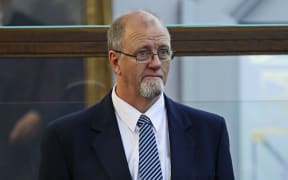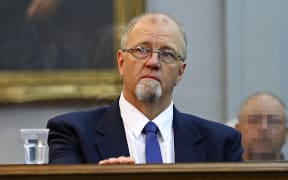"No husband should have his wife's brain on their shirt." That's Crown lawyer Philip Morgan's, QC, message for the Mark Lundy jury.

Photo: RNZ / Alexander Robertson
Mr Lundy, 56, is accused of murdering his 38-year-old wife, Christine Lundy, and seven-year-old daughter, Amber, whose bodies were found in their Palmerston North home on 30 August 2000; the Crown claims Mr Lundy killed his wife for her insurance money and Amber because she saw what he was doing to her mother.
The prosecution and defence have wound up more than six weeks of evidence and Mr Morgan this afternoon presented his closing argument.
"The Crown case to you is that Mark Lundy has his wife, Christine Lundy's, brain on his shirt. That is the effect of the evidence," Mr Morgan said.
"Mark Lundy had Christine Lundy's brain on his shirt in a case where she had her skull opened up and her brain splattered everywhere.
"The Crown's case, members of the jury, is that he's the killer, and he's the killer because he had his wife's brain on his shirt.
"No husband should have his wife's brain on their shirt."

Lead prosecutor Philip Morgan QC Photo: RNZ / Alexander Robertson
Mr Morgan said specialists from the United States, Britain and Europe had all agreed on one thing - the substance on Mr Lundy's shirt was CNS tissue, and several had said it had to be fresh CNS to become embedded in the fabric the way it was; dried CNS would not stick.
DNA experts found the smears on the shirt came from Mrs Lundy and no one else, he said. The samples of DNA were high quality and high quantity - not a trace.
"The sort of outcome you would expect from a substance such as blood or tissue."
Mr Morgan said the defence theory was that the CNS was from an animal and had come from food, and that Mrs Lundy had sneezed or coughed and her mucus - to identify her DNA - had landed on the same spot.
Mr Lundy would be the "unluckiest man in the world" for that sequence of events to have occured on the same day as his wife and daughter were murdered, he said.
Mr Morgan rejected the defence contention the CNS tissue got on to Mr Lundy's shirt via contamination and outlined the steps that would have taken; Glenn Weggery found the bodies and checked for Amber's pulse, an ambulance officer then went into the bedroom and got Mrs Lundy's brain on him, which he then transferred to Mr Weggery, who transferred it on to a police officer who sat next to him in a car.
That officer then oversaw the loading of Mr Lundy's car on to a tow truck before giving the key to another officer, who reached into the car to put it into neutral and unlock the steering, who then handed the key to another officer.
"And that's how it got on to the shirt inside out in the suit bag in the car," he said.
"It's a theory that has been floated out there in the hope that it might help [the defence]."
However, there was only one way the brain got on to Mr Lundy's shirt, Mr Morgan said.
"It's because he was in the room when the brain was flying around, and he got it on his shirt when he was cleaning up the mess."
Travel times and distances addressed
Mr Morgan then addressed what he said was a mileage discrepancy in Mr Lundy's car. The car had 80,589km on the clock when it was serviced on 21 August, he said. Nine days later, when Mr Lundy was stopped as he drove into Palmerston North, it had 81,859km on it.
The difference was 1270km but using Mr Lundy's accounts of his travel and cellphone records, the distance he travelled was actually only 847km, plus a bit for local travel, he said.
The 423km left was more than enough for the about 300km round trip from Petone to Palmerston North to carry out the killings.
"The accused's car tells us how far he travelled, the accused's shirt tells us where he went and what he did there."
"On this part of the case, there it is. It's not really something that requires a lot of ... you're not relying on anything other than what the car itself says."
Mr Lundy's fuel tank also told a story, Mr Morgan said.
He had filled up in Lower Hutt on the afternoon of 29 August, and his car's tank had a capacity of 68 litres.
When he was stopped driving into Palmerston North the fuel tank had only 10.1 litres left, meaning he has used 27.8 litres per 100km; Ford factory figures put the consumption of Ford Fairmonts at 13 litres per kilometre on the open road and 8 litres on the highway.
"His fuel consumption has become truly extraordinary - if he stayed at the Petone Foreshore," Mr Morgan said.
Mr Morgan will finish his closing address tomorrow, followed by the defence.

Mark Lundy's lead lawyer David Hislop, QC Photo: RNZ / Alexander Robertson
Official opening of defence case
Earlier today, lead defence lawyer David Hislop QC officially opened the defence case, although a number of expert defence witnesses had already appeared.
Mr Hislop told the court crucial to the Crown's case was that Mr Lundy took a "secret" round trip from Petone to Palmerston north to kill his family.
"There was no secret journey. He was in Wellington when they were murdered," Mr Hislop said.
The jury would not hear from Mr Lundy as there was "simply no need", and he was not obliged to give evidence.
"After all, it's the prosecution who brought him here, and they have to prove [their case]," he said.
"You know what he says. He's repeatedly said it. 'I did not kill my wife and child. I was in Wellington'."
"Really, he can't tell you much at all, so there's little point. The Crown brought this case and it's for them to prove it."
Mr Hislop said the defence case was "sort of like a jigsaw" - it would take the pieces they believed best demonstrated Mr Lundy's case he was innocent.
"The defence is, as doubtless you've worked out, it was simply impossible for that man to have murdered his wife and child on the 29 or 30 of August. Simply impossible."
If Mr Lundy remained in Petone, as the defence contended, then it did not matter if the CNS tissue found on his shirt was human or animal; all it proved was he was a "sloppy" eater, Mr Hislop said.
Justice Simon France is expected to sum up on Monday, and the jury will then begin deliberating.
*Clarification - For the avoidance of doubt, please note that Radio New Zealand reporter Sharon Lundy is no relation to Mark Lundy.




